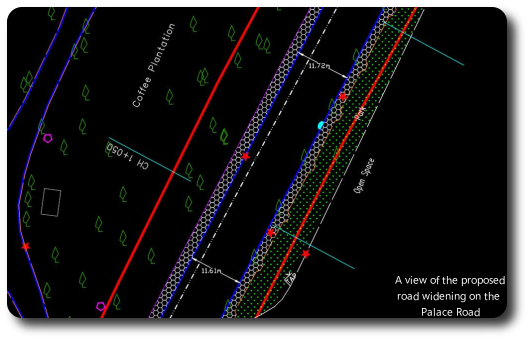Date: Thursday, 20th December 2007
Venue: Senate Hall, Central College, Bengaluru
Programme
Display of Road Widening Scheme Drawings: 4:00 PM – 5:00 PM
Discussion on the Scheme: 5:00 PM – 7:00 PM
The Chief Secretary, Government of Karnataka and Members of the Bangalore Metropolitan Land Transport Authority are expected to actively participate in these proceedings.

The event is organized by, Hasiru Usiru, Environment Support Group, CIVIC, and Alternative Law Forum.
You can access the drawings from this link (thanks to Arun who is with hasiru) or from the ESG website.
On either sites you will find drawings for:
Airport Road (1 2)
Bellary Road (1 2 3 4 5)
Devanga hostel Road (1)
Hosur Road (1 2 3 4)
Jayamahal Road (1)
Kasturba Road (1)
Nrupathunga Road (1 2)
Palace Road (1 2)
Race Course Road (1)
Sheshadri Road (1 2)
You can read more about the event, including the letter sent by the organizers to Shri P.B Mahishi Chief Secretary & chairman to the Bangalore Metropolitan Land Transport Authority at the bangalorebuzz.wordpress.com site.


Comments
the problem is within us
I am part of the Hasiru Usiru. I had attended this meet, and made a presentation also, the matter being the same as posted by me under "Better bussing for a green Bangalore". However, the following posting I made in the HU y-group will show where the problem largely lies.
That improved bus services is the most cost-effective answer to the exponentially increasing traffic, and attendant problems, in the city has been known for ages. But, neither the government nor the people want to look beyond BMTC to provide it - some because of vested interests, some because of dogma, some due to a lack of awareness, and some because of a combination of all these factors.
Yes, there are the lot, who in their fascination with the ‘growth’ of the economy, seem oblivious of the stress we are subjecting mother earth to. In that respect, Das’s presentation has considerable relevance, and, with his permission, I am proposing to pass it on to various groups, more particularly ones like CMCA (Children’s Movement for Civic Awareness), supported by the Public Affairs Centre.
When I originally proposed to make my presentation at the public meeting on Thursday, there was every effort to dissuade me. At the meeting, every effort was made to hurry me through, so much so, I was quite distracted and missed out on many aspects that I wanted to bring out before the gathering. The press release, as well as the display material at the venue, didn’t seem to carry any of the points that I was making. The specific mention of ‘facilitating entry of private players into bus services’ in the Urban Transport Policy (read: http://traffic-transport-...) was deliberately omitted. I was asked specifically to state that the views expressed were my own.
Now, the question that arises is where do the people responsible for all these fit into in the list that I have made out at the end of the first para? I must admit I am a little perplexed. In their desperation to see that the TVS’s and TATA’s don’t get into the picture, aren’t they subverting the interests of the HU? Isn’t TVS already amongst the biggest beneficiaries under the existing scenario, recording as it is perhaps the highest sales in the world for its two-wheelers in the city of Bangalore? And, aren’t TATA’s set to follow suit with their Rs1-lakh car?
There’s no denying that the private sector players have shown us the way in the other sectors which have been liberalized, with everyone concerned including the poorest of the poor benefiting considerably. Admittedly, there are corrections required. But, that doesn’t mean we should continue to suffer and pay for the burdens imposed by the public sector monopolies.
Muralidhar Rao
What about the trees?
Alternatives
The arrows in the picture